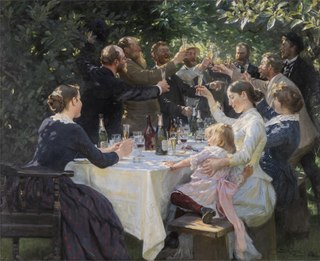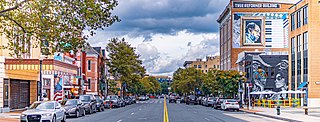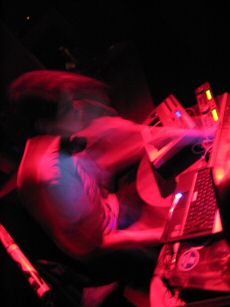
A disc jockey, more commonly abbreviated as DJ, is a person who plays recorded music for an audience. Types of DJs include radio DJs, club DJs, mobile DJs, and turntablists. Originally, the "disc" in "disc jockey" referred to shellac and later vinyl records, but nowadays DJ is used as an all-encompassing term to also describe persons who mix music from other recording media such as cassettes, CDs or digital audio files on a CDJ, controller, or even a laptop. DJs may adopt the title "DJ" in front of their real names, adopted pseudonyms, or stage names.

A party is a gathering of people who have been invited by a host for the purposes of socializing, conversation, recreation, or as part of a festival or other commemoration or celebration of a special occasion. A party will often feature food and beverages, and often conversation, music, dancing, or other forms of entertainment.

A rave is a dance party at a warehouse, club, or other public or private venue, typically featuring performances by DJs playing electronic dance music. The style is most associated with the early 1990s dance music scene when DJs played at illegal events in musical styles dominated by electronic dance music from a wide range of sub-genres, including drum and bass, dubstep, trap, break, happy hardcore, trance, techno, hardcore, house, and alternative dance. Occasionally live musicians have been known to perform at raves, in addition to other types of performance artists such as go-go dancers and fire dancers. The music is amplified with a large, powerful sound reinforcement system, typically with large subwoofers to produce a deep bass sound. The music is often accompanied by laser light shows, projected coloured images, visual effects and fog machines.

The Haçienda was a nightclub and music venue in Manchester, England, which became famous during the Madchester years of the 1980s and early 1990s. It was run by the record label Factory Records.

A promenade dance or promenade, commonly called a prom in American English, is a dance party for high school students. It may be offered in semi-formal black tie or informal suit for boys, and evening gowns for girls. This event is typically held at or near the end of the school year. There may be individual junior and senior proms or they may be combined.

Washington, D.C., has been home to many prominent musicians and is particularly known for the musical genres of Jazz, Rhythm & Blues, bluegrass, punk rock and its locally-developed descendants hardcore and emo, and a local funk genre called go-go. The first major musical figure from District of Columbia was John Philip Sousa, a military brass band composer. Later figures include jazz musicians, such as Duke Ellington, Charlie Rouse, Buck Hill, Ron Holloway, Davey Yarborough, Michael A. Thomas, Butch Warren, and DeAndrey Howard; soul musicians, including Billy Stewart, The Unifics, The Moments, Ray, Goodman & Brown, Van McCoy, The Presidents, The Choice Four, Vernon Burch, guitarist Charles Pitts, and Sir Joe Quarterman & Free Soul.

Paradise Garage, also known as "the Garage" or the "Gay-rage", was a New York City discotheque notable in the history of dance and pop music, as well as LGBT and nightclub cultures. The 10,000 square feet (930 m2) club was founded by sole proprietor Michael Brody, and occupied a building formerly located at 84 King Street in the SoHo neighborhood. It operated from 1977 to 1987 and featured resident DJ Larry Levan.

A quinceañera is a celebration of a girl's 15th birthday that is common in Mexican and other Latin American cultures. The girl celebrating her 15th birthday is a quinceañera. In Latin America, the term quinceañera is reserved solely for the honoree; in English, primarily in the United States, the term is used to refer to the celebrations and honors surrounding the special occasion.

The Fridge was a nightclub in the Brixton area of South London, England, founded, in 1981, by Andrew Czezowski and Susan Carrington, who had run the Roxy during punk music's heyday in 1977. The Fridge closed on 17 March 2010 and has no link with Electric Brixton which opened in September 2011 and now occupies the building.

A DJ mixer is a type of audio mixing console used by disc jockeys (DJs) to control and manipulate multiple audio signals. Some DJs use the mixer to make seamless transitions from one song to another when they are playing records at a dance club. Hip hop DJs and turntablists use the DJ mixer to play record players like a musical instrument and create new sounds. DJs in the disco, house music, electronic dance music and other dance-oriented genres use the mixer to make smooth transitions between different sound recordings as they are playing. The sources are typically record turntables, compact cassettes, CDJs, or DJ software on a laptop. DJ mixers allow the DJ to use headphones to preview the next song before playing it to the audience. Most low- to mid-priced DJ mixers can only accommodate two turntables or CD players, but some mixers can accommodate up to four turntables or CD players. DJs and turntablists in hip hop music and nu metal use DJ mixers to create beats, loops and so-called scratching sound effects.
Electronic dance music (EDM) is a broad range of percussive electronic music genres originally made for nightclubs, raves, and festivals. It is generally produced for playback by DJs who create seamless selections of tracks, called a DJ mix, by segueing from one recording to another. EDM producers also perform their music live in a concert or festival setting in what is sometimes called a live PA. Since its inception EDM has expanded to include a wide range of subgenres.

David Alistair Pearce is an English dance DJ, EDM producer and broadcaster, who has performed across the United Kingdom and the world. He previously presented Dance Anthems on BBC Radio 1 for ten years. He is renowned for playing a key role both as a performer and behind the scenes in the development of English dance and club culture.
The Perth Dance Music Awards highlights the year's major accomplishments in Electronic music by Western Australians. It is an annual event, with the first awards held in 1998. The Perth Dance Music Awards aim to provide recognition and reward to those who are the best in their chosen fields with in the Perth electronic music scene. The recipients of the awards are voted for by the public.
A DJ mix or DJ mixset is a sequence of musical tracks typically mixed together to appear as one continuous track. DJ mixes are usually performed using a DJ mixer and multiple sounds sources, such as turntables, CD players, digital audio players or computer sound cards, sometimes with the addition of samplers and effects units, although it is possible to create one using sound editing software.

Live PA is the act of performing live electronic music in settings typically associated with DJing, such as nightclubs, raves, and more recently dance music festivals.

A nightclub is a club that is open at night, usually for drinking, dancing and other entertainment. Nightclubs often have a bar and discothèque with a dance floor, laser lighting displays, and a stage for live music or a disc jockey (DJ) who mixes recorded music. Nightclubs tend to be smaller than live music venues like theatres and stadiums, with few or no seats for customers.

The Beacham Theatre is a cinema built in 1921 by Braxton Beacham Sr. in the city of Orlando, Florida. The current address of the theater is 46 North Orange Avenue, and it is located at the southwest corner of Orange Avenue and Washington Street. The building's current lack of impressive architecture is offset by its significant cultural history. The Beacham Theatre was considered an important contributing structure when the Downtown Orlando historic district was created in 1980 and the building was granted local landmark status in 1987.

Steve Blakley, also known by his alias Fury is an American DJ, rave promoter, and former professional snowboarder based in Denver, Colorado. In the 1980s and 1990s he was sponsored by Barfoot and Division 23 as an athlete, traveling to international snowboarding expos and competing in contests such as the U.S. Snowboarding Open. He began DJing as DJ Fury in 1992, adopting the styles of hardcore techno, drum and bass, breakbeat, and jungle. In 2000 the publication Denver Westword called him "Denver's premier jungle DJ." He tours frequently to festivals such as Electric Daisy Carnival, Paradiso, and Electric Forest Festival, often in collaboration with MC Dino, and as of 2014 is a resident DJ for Reload Productions, Beta Nightclub & Bassrush.

KW – Das Heizkraftwerk was a nightclub in Munich, Germany from 1996 to 2003. The techno club belonged, besides the Tresor and E-Werk in Berlin, the Dorian Gray and Omen in Frankfurt, and the Munich-based clubs Ultraschall, Natraj Temple and Millennium, to the most renowned clubs of Germany's 1990s techno culture.
Hot Mass is an electronic music dance party held weekly since December 2012 below Club Pittsburgh, a private gay club and bathhouse in Pittsburgh, Pennsylvania, United States. The event indirectly grew out of Pittsburgh's LGBT, disco, and electronic music subcultures of the 1970s, 1980s, and 1990s. Critics have noted the experience and quality of music at Hot Mass is difficult to find elsewhere in the United States, comparing it favorably to European nightclubs and parties, including Berghain.


















